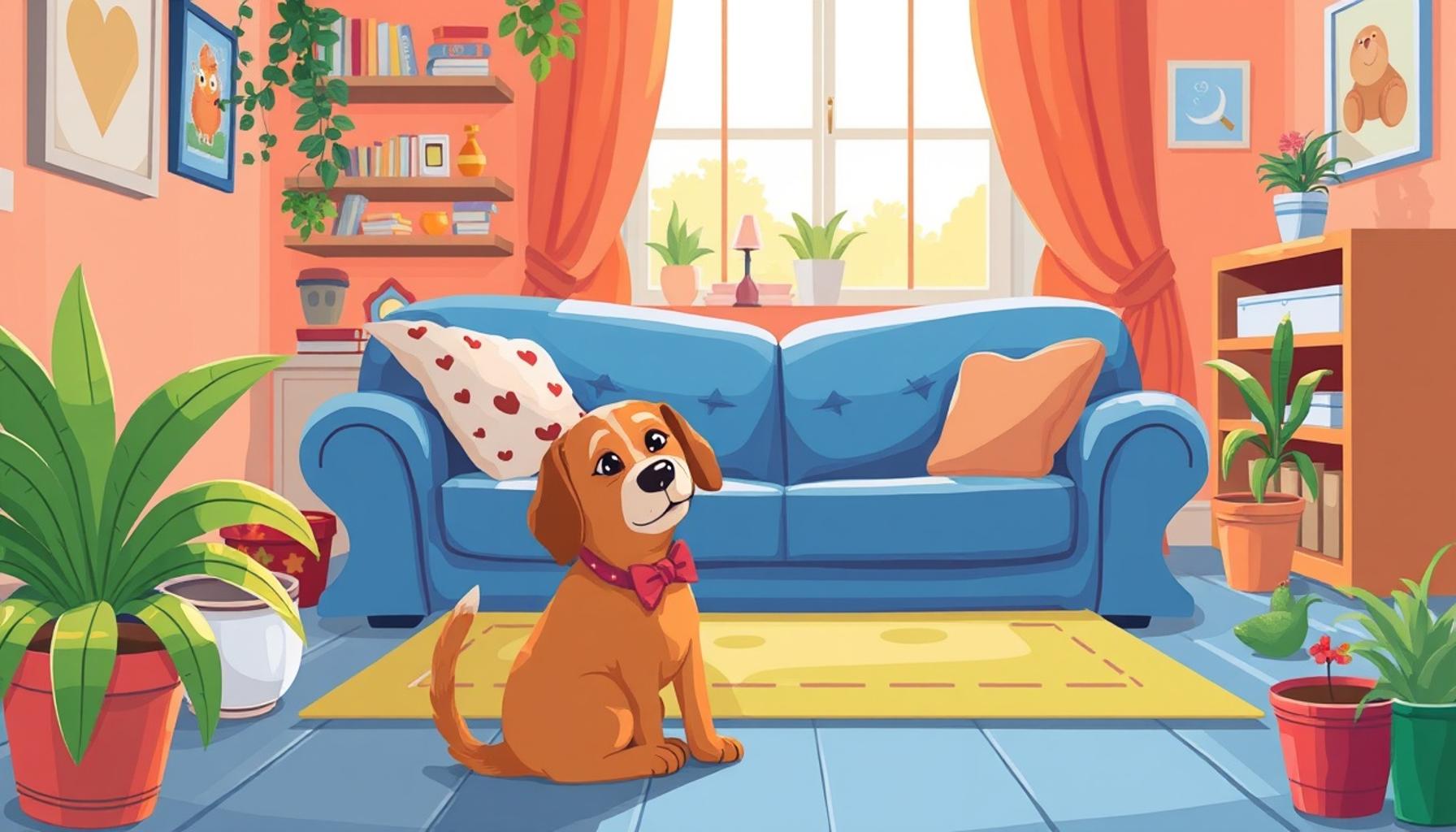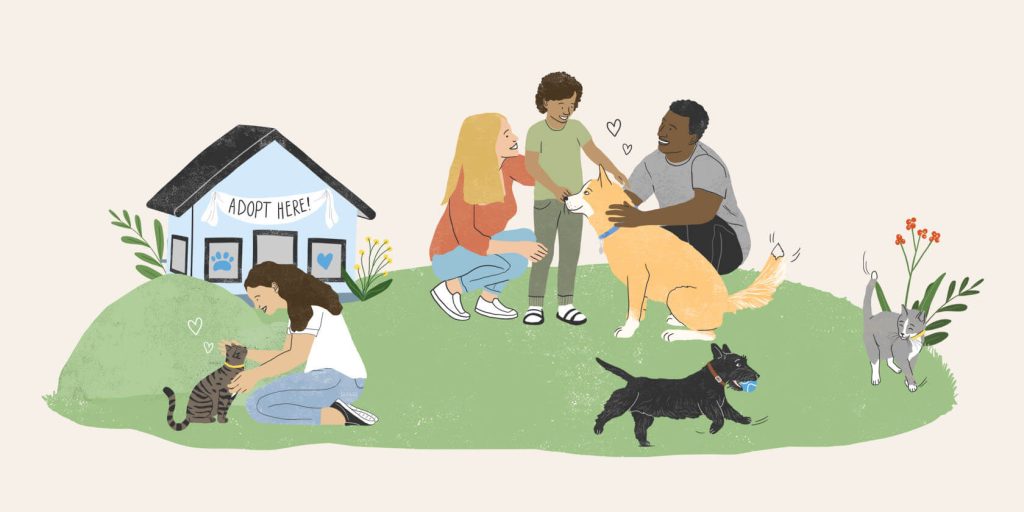How to Prepare Your Home to Welcome an Adopted Pet: Essential Tips

Setting the Stage for Your New Companion
Bringing an adopted pet into your home creates a delightful atmosphere brimming with excitement and love. This experience, however, extends beyond mere happiness; it entails a profound commitment to the health and well-being of your new furry family member. Consequently, ensuring that your living environment is both safe and inviting is crucial. This preparation phase not only facilitates a smoother transition for your pet but also fosters a deeper bond between you and your new companion.
Pet-proofing Your Home
One of the first steps in making your home pet-friendly is to pet-proof your space. This involves a thorough assessment of your home to identify and remove any hazardous items or substances that could pose a risk to your pet. Common culprits include household cleaners, medications, and small objects that could be swallowed. For instance, ensuring that electrical cords are hidden or covered reduces the chance of curious pets getting tangled or electrocuted.
Moreover, it’s prudent to secure any heavy furniture that might tip over, as pets (especially lively puppies) are known for their playful antics. This precaution protects not only your furniture but also the playful spirit of your new friend.
Creating a Designated Space
Another fundamental aspect of welcoming your new pet is to create a designated area within your home. This space should be a comfortable retreat where your pet can relax, sleep, and feel secure. Consider outfitting this spot with a cozy bed, blankets, and perhaps a few toys. For dogs, proximity to the family can be soothing, while cats often prefer a quieter, more elevated space. Cat trees or shelves can effectively turn vertical spaces into a delightful playground, keeping your feline friend engaged and satisfied.
Gathering Essential Supplies
Before your pet arrives, be sure to gather necessary supplies to keep them happy and healthy. Essential items include food and water bowls, quality pet food suited to your pet’s age and needs, toys for mental stimulation, and comfortable bedding. For dogs, leashes and harnesses for outdoor exercise are crucial, whereas cats may enjoy a variety of toys, scratching posts, and climbing structures. Small pets, such as rabbits or hamsters, require secure cages and appropriate bedding to ensure their safety and comfort.

Understanding Individual Needs
Recognizing that different species have unique needs will significantly aid you in creating a harmonious living environment. For example, dogs thrive on regular outdoor activity and socialization, which means dedicating time each day for walks and playtime is essential for their physical and mental health. Cats, on the other hand, may need stimulating environments, which could involve interactive toys and opportunities to climb or scratch. Small pets, such as guinea pigs or rabbits, thrive in spacious enclosures that allow for exploration and interaction.
By investing effort into these preparatory steps, you create a home that is more than just shelter; it becomes a sanctuary where love, comfort, and safety unite. Embrace this opportunity to transform your abode into a welcoming haven for your adopted pet, setting the stage for a fulfilling journey together.
DIVE DEEPER: Click here to learn more about the importance of pet adoption
Creating a Safe and Inviting Environment
As you prepare to welcome your new furry friend, it is vital to curate an environment that not only prioritizes safety but also reflects warmth and affection. Each pet comes with its own personality, and understanding their needs can significantly enhance their transition into your home. Let’s explore some essential steps to ensure your space is ready for your upcoming addition.
Pet-proofing Your Living Space
First and foremost, pet-proofing your home is a crucial step in preparing for your adopted pet. This process should ideally begin before your pet arrives, helping you create a safer environment. Here are some key areas to focus on:
- Secure Hazardous Substances: Ensure that cleaning supplies, medications, and other toxic substances are out of reach, preferably in cabinets with child-proof locks.
- Hide Electrical Cords: Cover cords or use cord management products to prevent pets from chewing on them, which could lead to serious injuries.
- Remove Small Objects: Items such as coins, rubber bands, and other small objects can pose choking hazards for curious pets.
- Check for Escape Routes: Ensure that windows and doors are secure to prevent accidental escapes, particularly during the initial adjustment period.
- Stabilize Furniture: Heavy furniture should be anchored to walls to prevent tipping accidents as your new pet explores their surroundings.
Establishing a Comfortable Retreat
Next, creating a designated area for your pet within your home will provide them with a sense of security. This space should be welcoming and comfortable, encouraging your new companion to feel at ease. Consider including the following elements:
- Cozy Bed: A soft, supportive bed or blanket will serve as a comforting spot where your pet can curl up and rest.
- Toys: Interactive toys can keep your pet engaged, reducing the likelihood of anxiety and destruction as they adapt to their new surroundings.
- Feeding Area: Set up a specific location for feeding and drinking to help establish routines.
- Safe Retreat: Cats, in particular, benefit from having hiding spots or elevated perches where they can observe their environment from a safe distance.
Collecting Essential Supplies
As you prepare for your pet’s arrival, don’t forget to gather essential supplies that will contribute to their comfort and well-being. This collection should include:
- Food and Water Bowls: Choose bowls that are appropriate for your pet’s size and eating style—elevated feeders for larger breeds can help with digestion.
- Quality Pet Food: Consult with your veterinarian to select the best diet suitable for your new pet’s age, breed, and health needs.
- Training Supplies: Items such as leashes, harnesses, and training pads are essential for establishing good habits early on.
- Grooming Tools: Depending on the type of pet, a basic grooming kit can help keep their coat healthy and free of tangles.
In these early days of preparation, your proactive measures will set the groundwork for a loving, safe environment. By prioritizing safety and comfort, you are not only protecting your new pet but also laying the foundation for a rewarding journey together. Your home is about to transform into a vibrant sanctuary filled with love and companionship, so embrace this exciting opportunity to create an inviting haven for your adopted pet!
How to Prepare Your Home to Welcome an Adopted Pet: Essential Tips
Bringing an adopted pet into your home is a fulfilling journey, but it requires careful planning and a few adjustments to ensure a smooth transition for your new furry family member. Here are essential tips to help you prepare your home effectively.
1. Create a Safe Space
Your new pet will need a designated area that feels safe and comfortable. This space can be a quiet room or a cozy corner with a bed, toys, and water. Setting up this sanctuary will allow them to adjust slowly to their new environment.
2. Pet-proof Your Home
Ensure your living space is free from hazards. Move harmful substances like cleaning supplies, electrical cords, and delicate items out of reach. A safe environment minimizes anxiety for both you and your new pet.
3. Stock Up on Supplies
Before bringing your pet home, gather essential supplies such as food, water bowls, a leash, grooming tools, and toys. Creating a checklist will make this process easier and ensure nothing is forgotten.
4. Plan for Training
Approach training with patience and positivity. Establish house rules early and decide on a training method that suits your pet’s personality. Consistency will help your adopted pet learn and adapt comfortably.
5. Consult with a Veterinarian
Make an appointment with a veterinarian shortly after adoption. Regular check-ups, vaccinations, and preventive care are essential aspects of keeping your pet healthy and addressing any medical concerns promptly.
6. Introduce Family Members Gradually
Help your family and your new pet to ease into their relationship. Allow time for everyone to meet in a controlled manner. Use positive reinforcement to encourage good behavior from both your family and your new furry companion.
7. Create a Pet Schedule
Organize a daily routine that includes feeding times, walks, play sessions, and training intervals. A consistent schedule aids in acclimatizing them to their new life and strengthens the bond between you and your adopted pet.
| Category | Advantages |
|---|---|
| Safety | A secure environment reduces risks and helps your pet feel at ease. |
| Routine | Establishing a daily schedule fosters stability, promoting good behavior and a sense of security for your adopted pet. |
By following these essential tips, you can create a loving and secure environment that will help your adopted pet thrive in their new home. Every small effort counts towards making their transition a positive and loving experience.
LEARN MORE: Click here to discover effective training techniques for your cat
Setting Up a Routine for Success
Transitioning into a new home can be daunting for your adopted pet, but establishing a consistent routine can help them feel secure and adapt faster. Schedules create a sense of predictability, reducing anxiety and enhancing overall well-being. Let’s delve into crucial elements for crafting an effective daily routine that will benefit both you and your furry friend.
Establish a Feeding Schedule
Feeding time is not just about nourishing your pet; it’s a part of their routine that can help them feel more settled. Consistency in meal times fosters trust and signals to your pet that they are in a nurturing environment. For example, plan to feed your pet at the same time each day, as this can mimic the natural patterns they had before adoption. Consult your veterinarian to determine the right type of food and the appropriate quantity based on your pet’s specific needs.
Implement Regular Exercise and Playtime
Engaging your pet in daily physical activities is fundamental to their mental and physical health. Whether it’s a brisk walk for dogs or interactive play sessions for cats, routine exercise is crucial. Dogs generally thrive on 30 minutes to two hours of exercise daily, depending on their breed and energy level. For cats, interactive toys and laser pointers can provide ample stimulation. The key is to integrate these activities into your daily schedule. This not only helps with bonding but also assists in burning off excess energy, which can prevent undesirable behaviors like chewing or scratching.
Socialization and Training
Socialization is vital for a pet’s development, especially for puppies and kittens. Introducing your adopted pet to various environments, people, and other animals can help them adjust better to new situations. Consider enrolling them in a training class designed for their age and breed. Positive reinforcement training not just aids in behavior management, but it also strengthens the bond between you and your pet. Aim for short, engaging training sessions of about 5 to 15 minutes, as pets can become bored or overwhelmed with longer periods.
Creating a Bedtime Routine
Just like humans, pets benefit from a relaxing bedtime routine that signals the end of the day. Establishing consistent bedtime rituals, such as quiet play, gentle brushing, or slow walks before sleep, can promote relaxation. Aim to keep the lights dim and minimize noisy activities during this time, helping your pet to wind down. A calm and serene atmosphere will encourage your new pet to find their sleeping spot quickly.
Monitoring Adjustments and Behavioral Changes
As your adopted pet gets acclimated to your home, keep an eye out for signs of stress or discomfort. Changes in behavior such as excessive hiding, barking, or signs of aggression may indicate that they are struggling with the transition. Be proactive in addressing these issues. Patience is key; allow your pet to adjust to their new surroundings at their own pace. Spend time observing their habits, enabling you to identify what comforts them or what might be causing distress.
By thoughtfully structuring your pet’s daily routine, you can provide them with both stability and reassurance. These well-planned practices will create an atmosphere where your adopted pet can thrive, making your home a loving haven that welcomes them wholeheartedly. As you embark on this rewarding journey together, the commitment to creating a nurturing routine will significantly enhance your relationship throughout the years ahead.
LEARN MORE: Click here for important pet health insights
Conclusion
Welcoming an adopted pet into your home is not only a heartwarming experience but also a significant responsibility. By implementing the essential tips outlined in this article, you can create an environment that promotes comfort, security, and happiness for your new furry family member. Establishing a secure living area, maintaining a predictable routine, and offering love and attention are crucial steps that facilitate the adjustment period and help cultivate a lasting bond.
Remember, the foundation of a harmonious relationship with your pet rests on patient socialization, consistent training, and understanding their unique needs. Regular exercise, engaging playtime, and a soothing bedtime routine can all contribute to a thriving household for both you and your adopted pet. Moreover, closely monitoring their behavior will enable you to recognize signs of stress or discomfort, allowing you to take proactive measures to support their well-being.
As you prepare your home and heart for the arrival of your adopted companion, consider this journey an adventure filled with joy, learning, and companionship. With your commitment and care, you can transform your home into a nurturing sanctuary, making it a place where both you and your pet can flourish together. So take those first steps today—your new best friend is waiting to embark on this exciting chapter with you!


